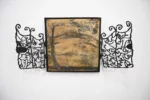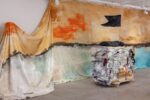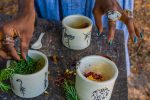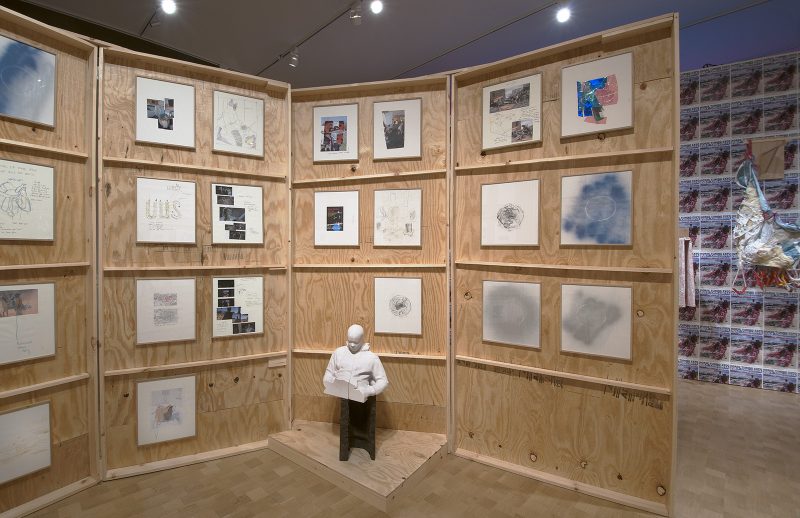
Immediately upon entering the special exhibition galleries at the Barnes Foundation it is obvious that this is not business as usual. On view through October 2, “Mohamed Bourouissa; Urban Riders,” is in your face with a huge diagonal wall covered in a checkerboard of red, white and blue posters and the ambient sounds of crowds alternating with conversations. To the left is a semicircular structure of rough wooden plywood hung with multiple rows of the artist’s sketches, and the wall bisecting the gallery at an angle is also hung with a series of unruly and colorful three-dimensional objects which turn out to be costumes for an equestrian event. The spacial effect is masterful, entirely transforming the gallery. The sounds come from the video in the small adjacent room, and around the corner is a second, large gallery hung with wall reliefs.
Bourouissa, an Algerian-born French artist developed an international reputation with a series of works which presented portraits of marginalized urban residents – often youth, but also prisoners, low-income workers and the unemployed – with a dignity rarely accorded them in the press, where they are usually shown as symptoms of urban problems and/or perpetrators of crime and violence. Bourouissa’s presentation of these populations – beginning with his neighbors in the poor, immigrant communities that ring Paris – in the white-walled precincts of the art world was considered as a political statement. It introduced the educated and often wealthy art community to neighbors they had never faced – intentionally so, based on the class-segregated housing that characterizes Western cities. [I am not at all sure that this practice is confined to the West].
Fletcher Street Urban Riding Club
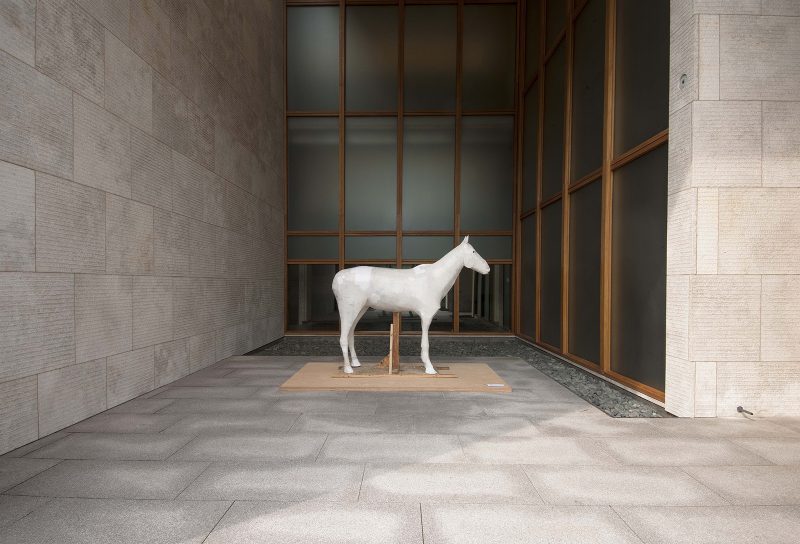
Bourouissa came to Philadelphia initially for a residency with Fletcher Street Urban Riding Club in North Philadelphia. The Barnes exhibition is an outgrowth of that residency. The exhibition introduces these urban riders in a 14-minute, two channel video installation, “Horse Day,” which includes footage of their everyday activities around the horses. It also features an event the artist organized in which he invited a number of Philadelphia artists to work with the riders to develop costumes for the horses, which became part of a public riding event. On the wall are posters of the event’s announcements, and the objects hanging on the wall are the bespoke horse costumes.
Bourouissa spent eight months with the club members, developing relationships and trust. He may have grown up in an equivalently-marginalized area of Paris, but he was an outsider here. And, in his romanticized association of men on horses with cowboys – only these were urban, African American cowboys – he brought up a theme that the men themselves reject. I suspect I am not alone in associating men on horses in the city with mounted police rather than the Old West. In fact the Fletcher Street Urban Riding Club has a hundred-year history, and these men are riding horses for their own pleasure, not as work, as it is with cowboys and police. In that sense they disrupt an even less likely association; amateur horse riding has traditionally been the province of the wealthy, whether in urban, suburban or rural neighborhoods. Rather like Arthur Ashe and the Williams sisters in tennis and Tiger Woods in golf, the members of the Fletcher Street Urban Riding Club participate in a sport that has been traditionally seen as exclusively white and upper class.
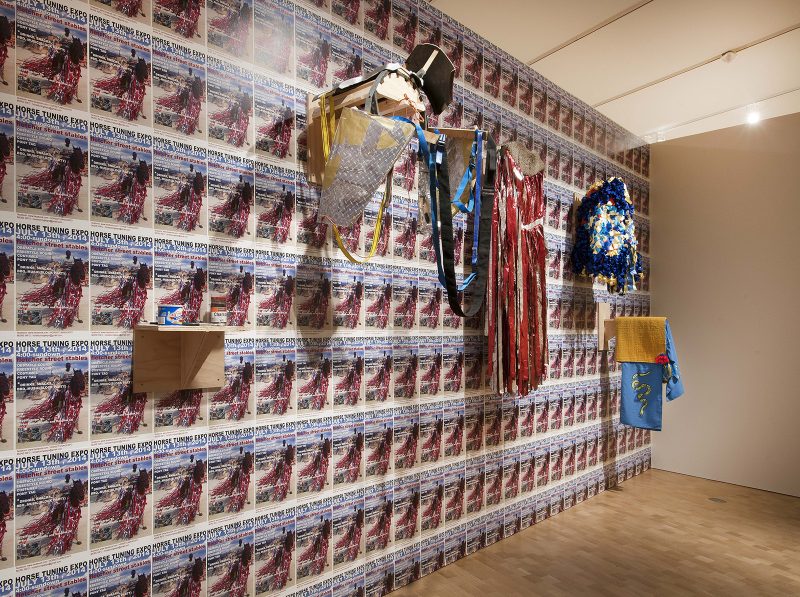
The artists who worked with the riders did an imaginative job with the costumes, made largely with materials found on the street or bought from dollar stores. Max Lussenhop and Billy Dufala used the sort of mylar cut into thin strips that one sees at auto dealerships; they created a blanket cover that sparkled in the sun and highlighted the horse’s movement. Anthony Campuzano and Kate Abercrombie used winners’ ribbons to fashion a horse collar like those made of flowers for racing horse winners. Faith Mohnke’s design, a wreath of brightly-colored, fabric flowers, makes direct reference to those winner’s wreaths. Shelby Donnelly fashioned a horse blanket of cotton with her own, silk-screened pattern, and more spectacularly also made a collar from a large number of jump ropes which she partially dismantled, revealing their unexpected stuffing of fabric. An extraordinary costume seen in the video was constructed of shimmering music cds and looks like 20th century ceremonial horse armor. Theirs and work by Katie Coble, Jes Gamble and others is credited in the museum’s labeling, although not in the exhibition catalog which pictures many of the same pieces installed previously at European venues. The horsemen themselves are referred to strictly by first name. I don’t know whose decision that was.
“The Ride”
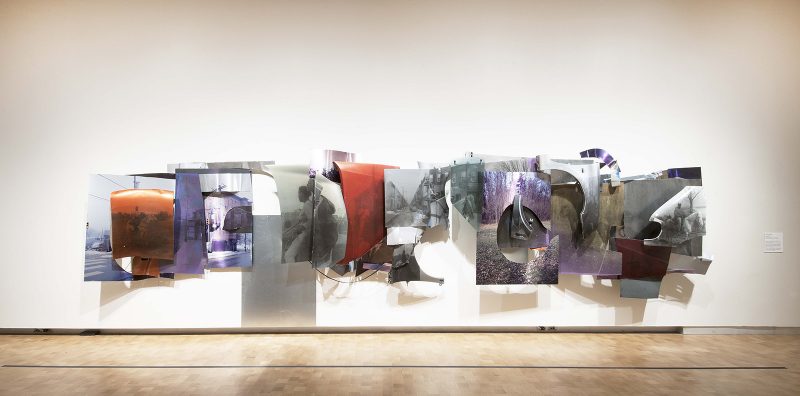
The second large gallery is filled with an installation by Bourouissa, “The Ride.” It consists of a series of large, dark and elegant wall reliefs created from assemblages primarily made of auto body parts; some are silk-screened with images of the urban riders. The artist considers them part of a larger project, “The Hood,” which he began three years ago. His comments suggest ideas of contrasting auto and horse cultures and the class difference between the riders and owners of expensive cars. The best of them are wonderful formal arrangements, but I could not make out the imagery well enough to evoke any ideas. And both their form and their combination of fragments of art and life were so physically and conceptually like some of Robert Rauschenberg’s work as to overwhelm most other ideas for me.
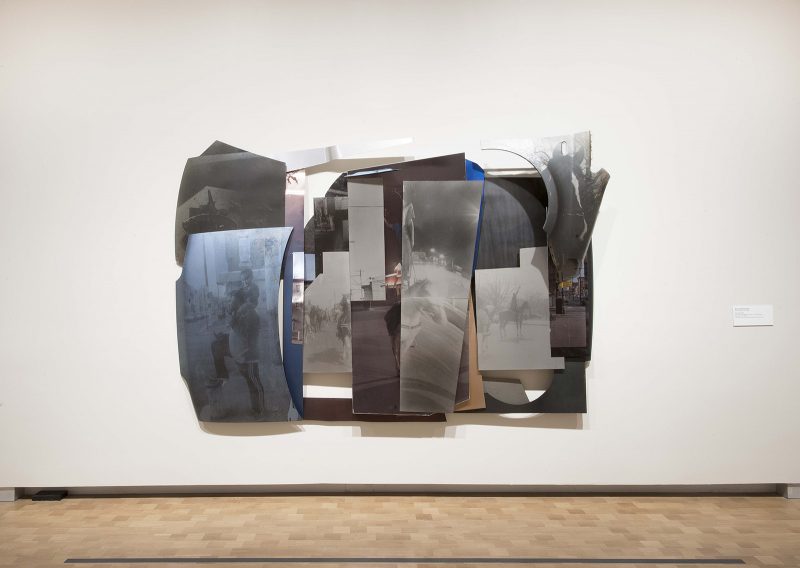
Bourouissa’s work with the riders resembles but does not entirely line up with the tenets of a genre come to be known as social practice. I am sure that the riders appreciated the careful attention and have a broader appreciation of art than they had previously. They are likely to attend the exhibition, along with friends and relatives. Whether that will lead to longer range connection to the Barnes and other museums remains to be seen. The Philadelphia artists expressed delight to have their work hanging at the Barnes; but Bourouissa’s stated intentions concern not any of them, but the museum’s usual visitors who the artist assumes will find the imagery of black men on horses at odds with their stereotypes of North Philadelphians. They will certainly come away with knowledge of this riding club and its long history, and probably more aware that a lot has been left out of conventional histories of our city, particularly as it concerns the African American and other minority communities.
Mohamed Bourouissa: Urban Riders is at the Barnes Foundation until October 2, 2017.



